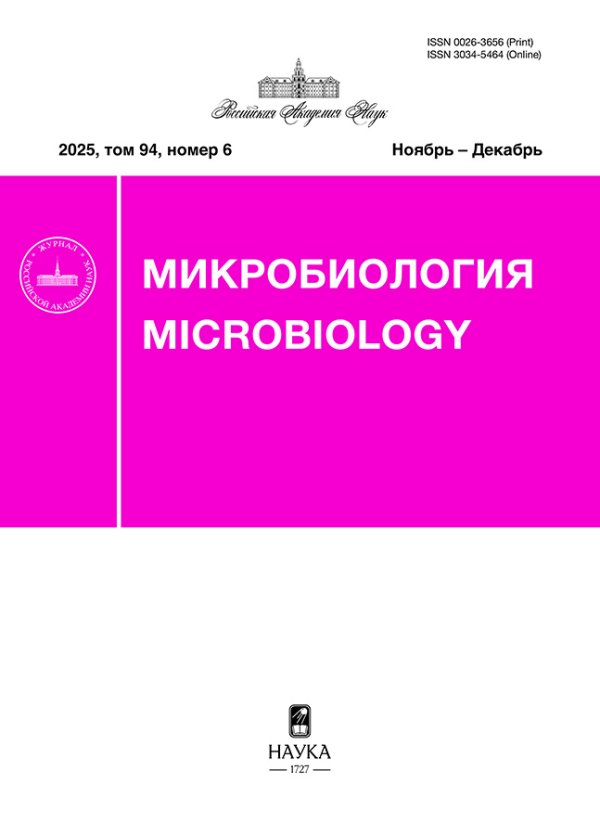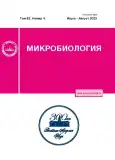Analysis of the Key Determinants of Naphthalene Degradation by Rhodococcus pyridinivorans 5Ар
- Authors: Larchenka A.Y.1, Mandryk M.I.1
-
Affiliations:
- Belarusian State University
- Issue: Vol 92, No 4 (2023)
- Pages: 418-426
- Section: EXPERIMENTAL ARTICLES
- URL: https://journals.rcsi.science/0026-3656/article/view/138218
- DOI: https://doi.org/10.31857/S0026365623600025
- EDN: https://elibrary.ru/RIWQWF
- ID: 138218
Cite item
Full Text
Abstract
Abstract—Wild-type cells of Rhodococcus pyridinivorans 5Ар were found to be highly efficient naphthalene degraders, completely utilizing this compound (500 mg/L) after 3 days, and may be used for remediation of naphthalene-contaminated aquatic ecosystems. Inactivation of the biodegradation genes narAa (encoding the large subunit of naphthalene dioxygenase) and narB (encoding cis-naphthalene dihydrodiol dehydrogenase) resulted it the loss of ability to use naphthalene as the sole energy source, which indicated the absence in the genome of R. pyridinivorans 5Ар of the determinants responsible for alternative pathways of naphthalene oxidation. Moreover, narB inactivation resulted in accumulation of a polar colored compound (probably a product of primary naphthalene oxidation) in the medium.
About the authors
A. Yu. Larchenka
Belarusian State University
Author for correspondence.
Email: larch.alina@gmail.com
Belarus, 220030, Minsk
M. I. Mandryk
Belarusian State University
Email: larch.alina@gmail.com
Belarus, 220030, Minsk
References
- Каталог штаммов региональной профилированной коллекции алканотрофных микроорганизмов / Под ред. Ившиной И.Б.. М.: Наука, 1994.
- Catalog of Strains of the Regional Profiled Collection of Alkanotrophic Microorganisms / Ed. Ivshina I.B. M.: Nauka, 1994.
- Маниатис Т., Фрич Э., Сэмбрук Дж. Методы генетической инженерии. Молекулярное клонирование / Пер. с англ. под ред.Баева А.А., Скрябина К.Г. М.: Мир, 1984. 479 с. Maniatis T., Fritsch E.F., Sambrook J. Molecular Cloning. A Laboratory Manual. New York: Cold Spring Harbor Laboratory, 1982. 545 p.
- Нафталин коксохимический. Технические условия: ГОСТ 16106-2019. введ. 01.03.20. Межгосударственный совет по стандартизации, метрологии и сертификации, 2019. 12 с. Расимович Б.Э. Биодеградация нефтезагрязнений под воздействием углеводородокисляющих микроорганизмов // НефтеГазоХимия. 2019. № 1. С. 48–51.
- Романенко В.И., Кузнецов С.И. Экология микроорганизмов пресных вод. М.: Наука, 1974. 194 с.
- Сазыкин И.С., Сазыкина М.А., Чистяков В.А. Разложение нефти микроорганизмами. Экологические аспекты // Известия ВУЗов. Северо-Кавказский регион. 2009. № 6. С. 88–92.
- Хант Дж. Геохимия и геология нефти / Пер. с англ. под ред. Вассоевича Н.Б., Архипова А.Я. М.: Мир, 1982.
- Hunt J. Petroleum Geochemistry and Geology. W.H. Freeman & Co, San Francisco, CA, 1979.
- Чернявская М.И., Букляревич А.А., Делеган Я.А., Охремчук А.Э., Филонов А.Е., Титок М.А. Биоразнообразие почвенных углеводородоокисляющих бактерий из разных климатических зон // Микробиология. 2018. Т. 87. С. 581‒594.
- Chernyavskaya M.I., Buklyarevich A.A., Delegan Ya.A., Okhremchuk A.E., Filonov A.E., Titok M.A. Biodiversity of soil hydrocarbon-oxidizing bacteria from different climatic zones // Microbiology (Moscow). 2018. V. 87. P. 699‒711.
- Чернявская М.И. Характеристика штаммов нафталинутилизирующих бактерий рода Rhodococcus // Труды БГУ: Микробиология. 2016. Т. 11. Ч. 1. С. 190–197.
- Chernyavskaya M.I. Characterization of strains of naphthalene-utilizing bacteria of the genus Rhodococcus // Proceedings of BSU: Microbiology. 2016. V. 11. Part 1. P. 190–197.
- Biodegradative Bacteria: How Bacteria Degrade, Survive, Adapt, and Evolve / Eds. Nojiri H., Tsuda M., Fukuda M., Kamagata Y. Springer Tokyo, 2014. 358 p.
- Bullock W.O., Fernandez J.M., Short J.M. XL1-Blue: a high efficiency plasmid transforming recA Escherichia coli strain with beta-galactosidase selection // BioTechniques. 1987. V. 5. P. 376–378.
- Cerniglia C.E. Biodegradation of polycyclic aromatic hydrocarbons // Curr. Opin. Biotechnol. 1993. V. 4. P. 331–338.
- Gennaro P.D. Identification and characterization of genes involved in naphthalene degradation in Rhodococcus opacus R7 // Appl. Microbiol. Biotechnol. 2010. V. 87. P. 297–308.
- Haritash A.K., Kaushik C.P. Biodegradation aspects of polycyclic aromatic hydrocarbons (PAHs): a review // J. Hazard. Maters. 2009. V. 169. P. 1–15.
- Inaba T. Analysis of genes for succinoyl trehalose lipid production and increasing production in Rhodococcus sp. strain SD-74 // Appl. Environ. Microbiol. 2013. V. 79. P. 7082–7090.
- Kimura N. Genetic and biochemical characterization of the dioxygenase involved in lateral dioxygenation of dibenzofuran from Rhodococcus opacus strain SAO101 // Appl. Microbiol. Biotechnol. 2006. V. 73. P. 474–484.
- Kulakov L.A. Web-type evolution of Rhodococcus gene clusters associated with utilization of naphthalene // Appl. Environ. Microbiol. 2005. V. 71. P. 1754–1764.
- Kuyukina M.S., Ivshina I.B. Bioremediation of contaminated environments using Rhodococcus // Biology of Rhodococcus. Microbiology Monographs / Ed. Alvarez H. Springer, Cham. 2019. V. 16. P. 231–270.
- Larkin M.J., Kulakov L.A., Allen Ch.C.R. Biodegradation and Rhodococcus – masters of catabolic versatility // Curr. Opin. Biotechnol. 2005. V. 16. P. 282–290.
- Li J.L., Chen B.H. Surfactant-mediated biodegradation of polycyclic aromatic hydrocarbons // Materials. 2009. V. 2. P. 76‒94.
- Metcaff W.W., Jiang W., Wanner B.L. Use of the rep technique for allele replacement to construct new Escherichia coli hosts for maintenance of R6Kgamma origin plasmids at different copy numbers // Gene. 1994. V. 138. P. 1–7.
- Mohapatra B., Phale P.S. Microbial degradation of naphthalene and substituted naphthalenes: metabolic diversity and genomic insight for bioremediation // Front. Bioeng. Biotechnol. 2021. V. 9. Art. 602445.
- Schäfer A. Small mobilizable multi-purpose cloning vectors derived from the Escherichia coli plasmids pK18 and pK19: selection of defined deletions in the chromosome of Corynebacterium glutamicum // Gene. 1994. V. 145. P. 69–73.
- te Riele H., Michel B., Ehrlich S.D. Single-stranded plasmid DNA in Bacillus subtilis and Staphylococcus aureus // Proc. Natl. Acad. Sci. USA. 1986. V. 83. P. 2541–2545.
- Vaidya S. Degradation of chrysene by enriched bacterial consortium // Front. Microbiol. 2018. V. 9. Art. 1333.
- Yang H. Degradation of recalcitrant aliphatic and aromatic hydrocarbons by a dioxin-degrader Rhodococcus sp. strain p52 // Environ. Sci. Pollut. Res. Int. 2014. V. 21. P. 11 086‒11 093.
Supplementary files













